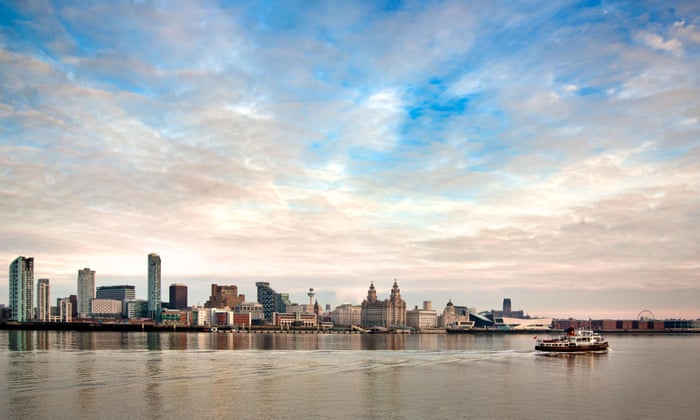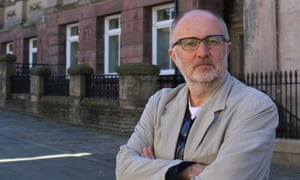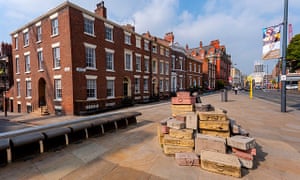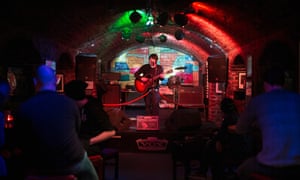 |
| Ferry good … the Liverpool waterfront, including Pier Head. Photograph: Alamy |
Roger Appleton, the director of a new documentary about Liverpool’s music scene – and not just the Fab Four – is inspired by the romantic and beautiful place he sees as ‘the least English of English cities’
Liverpool’s music scene is like the tide of the Mersey. It rolls in and brings fantastic songs and bands and then, for a little while, there’s a lull as it goes out. There’s almost a rhythm to its success.
I think many of the songs written here are inspired by the light and the river. Listen to a band like Echo and the Bunnymen and there’s often a lilting, lyrical feel to their tunes; compare it with a Manchester band of a similar period, like New Order, and their music is mechanistic, almost industrial.
To me Liverpool is the least English of English cities, and it’s one of the reasons I love living here. The population in the 1840s was relatively small (around 250,000) but from 1840-50 almost 1.3 million Irish people passed through here. Many moved on to the US or inland but the fact there were so many meant that by the 1860s you could walk around sections of the city and think you were in Ireland.
The best way to see the sights is to be a flâneur. I love this idea of strolling around taking in the buildings and atmosphere of a place. My partner has lived here all her life and I’ve been here for more than 30 years and we still get enormous pleasure from walking around. It can be the Victorian grandeur of the business district around Dale Street and Castle Street or the splendour of the Georgian Quarter around Hope Street, the street that runs between the city’s two cathedrals.
But if you want a proper sight to tick off the list, it has to be the Walker Art Gallery. I think it’s the best collection of paintings outside London. There are fantastic works from the early Renaissance period and because of the gallery’s association with the John Moores Painting Prize, there are great pieces by David Hockney, Peter Doig and Lucian Freud.
St George’s Hall is one of the most magnificent buildings in Britain – though one of my friends once referred to it as “our village hall”. It’s a Grade-II listed neo-classical hall that was built in the early 1800s for musical events, as well as being a civil and crown court.
Last year, a set of terraced streets in Liverpool won the Turner Prize. Just across the road from Ringo Starr’s childhood home on Madryn Street are four streets of fantastic Victorian houses. They had been allowed to deteriorate during the 1980s and 90s and the council wanted to knock them down but local residents fought to save them. The residents worked on a renovation programme with an art and architecture collective called Assemble, from London, and last year Granby Four Streets won the UK’s most prestigious art prize.
The Beatles have a lot to answer for. That’s the opening line of my documentary. The Beatles’ story has been told so many times and I thought it would be more interesting to highlight some of the other fantastic music made in Liverpool before, during and after the Beatles. It’s important not to overlook how good some of this stuff was. I wanted to put the Beatles in the context of all of the music that came out of Merseyside.
For years after the Beatles’ peak, bands in Liverpool were almost afraid to write songs. Pete Wylie from Wah! said: “John Lennon cast a shadow over me.” It wasn’t until the early 70s that more bands started to write their own stuff – Deaf School in particular. Eventually, the floodgates opened and that led to the scene that developed around Eric’s Club on Mathew Street, with Echo and the Bunnymen, OMD, Teardrop Explodes and, ultimately, Frankie Goes to Hollywood.
The Music Room has been a great addition to the city’s music venues. It’s an intimate space, opened last year with a capacity of 160-250, and is built on to the back of the Philharmonic Hall. It sees jazz and folk bands, world music, some blues, and while they’re not often the sort of performers who’d sell out a 1,000-seater venue, they are at the top in terms of talent.
The quality and diversity of bands at the Caledonia is extraordinary. I don’t know how this pub-venue manages it but there’s great live music, for free, five nights a week. There’ll be jazz, including the Blind Monk Trio, a fantastic Irish band called Saltcutters play regularly, the pub hosts Cajun sessions and you might also catch the Loose Moose String Band with their 1930s swing tunes.
Tony Benn told me a great story about coming to give a talk at the Philharmonic Hall. He said that he caught the train to Lime Street station and not knowing how to get to the hall asked people at a bus stop for directions. He said that not only did a man walk him to the hall but that by the time he arrived he’d also learned something about Rosa Luxemburg that he didn’t know.
Stand with your back to Princes Park gates and look down Princes Avenue – that’s my favourite view of this city. Princes Avenue is an extremely grand Victorian boulevard with a wide, green, central reservation, which is full of trees. It is lined with the most beautiful Victorian houses; you can almost imagine nannies in the 1890s wheeling their prams up and down that central reservation.
• Get Back, the Story of the City that Rocked the World, is out now on DVD




No comments:
Post a Comment